Last updated on April 28th, 2023
You must have heard that protein benefits your body in a significant manner. That’s why studies have been suggesting taking a high-protein breakfast to reduce food intake the whole day, feel fulfilled for a longer time, and thus effectively lose weight. Not only this, a protein-rich breakfast helps to build muscle as well (1) (2).
But why only breakfast and not lunch or dinner? Because breakfast is the first and most important meal of your day. You will read later in the article how eating protein in the morning can help you lose weight and keep energized all day long.
So, here’re 10 of my favourite high-protein breakfast recipes that my mom loves to cook and serve us. Earlier I didn’t know that her recipes are rich in protein. When I came to know about protein and did detailed research on it, I thought about sharing these tasty vegetarian recipes that are not only nutritious but fulfilling also.
If you’re an Indian, you’re going to love them.
Must read:
11 Vegetarian High-Protein Breakfast Recipes for Indians (with Pictures)
You can see food resources that are high in protein later in the article. I have picked protein-rich food for these breakfast recipes.
1. Air Fried Hari Matar/Rajma Poori or Parantha

Green peas and Kidney beans are one of the best food sources of protein if we talk about vegetarian foods.
So why make curry only? You can try different dishes. You’re going to need one bowl of boiled rajma or Matar. Smash it and mix it into the wheat flour.
Now make Poori with this dough. No, you don’t need to deep fry it. Ever heard of an air fryer or microwave convection? So, make it air fried. The recipe is super easy and tasty.
If you don’t like poori, make paranthas. Now, eat it with Dahi or you can eat it like Raj kachori with a filling of salad and sprouts.
Helpful:
- How to Buy an Air Fryer (+Reviews)
- Philips Air Fryer Review
- Recommended Convection Microwave for Home
2. Katori Chaat (Made With Wheat Flour)


Moong dal, peanut, and paneer are said to be protein-rich foods. So, I am going to use them for making Katori chaat.
Tasty Katori chaat can be made in three ways. You can either steam it like momos, air fry it or deep fry it. Then fill it with boiled Moong Daal. Add peanuts and paneer bhurji for taste. And garnish it with salad and vegetables.
Your high-protein breakfast is ready!
Don’t forget to spray masala, chutney, and sauce on it. These add-ons dramatically enhance the taste of your chaat.
3. Chickpea Non-Fried Pakode

My mother introduced me to this Pakore. It’s her recipe. To make this, you need chickpea flour or moong dal flour, some palak/methi saag (optional), and crushed Lauki. You can also use crushed paneer instead of Lauki.
Add spices, chilli powder, and salt to it.
Now make rolls with this dough and boil them. After that, cut it into pieces. Your protein-rich recipe is ready.
Garnish it with Dahi, salad, and jaljeera powder.
4. Moong Daal Chaat
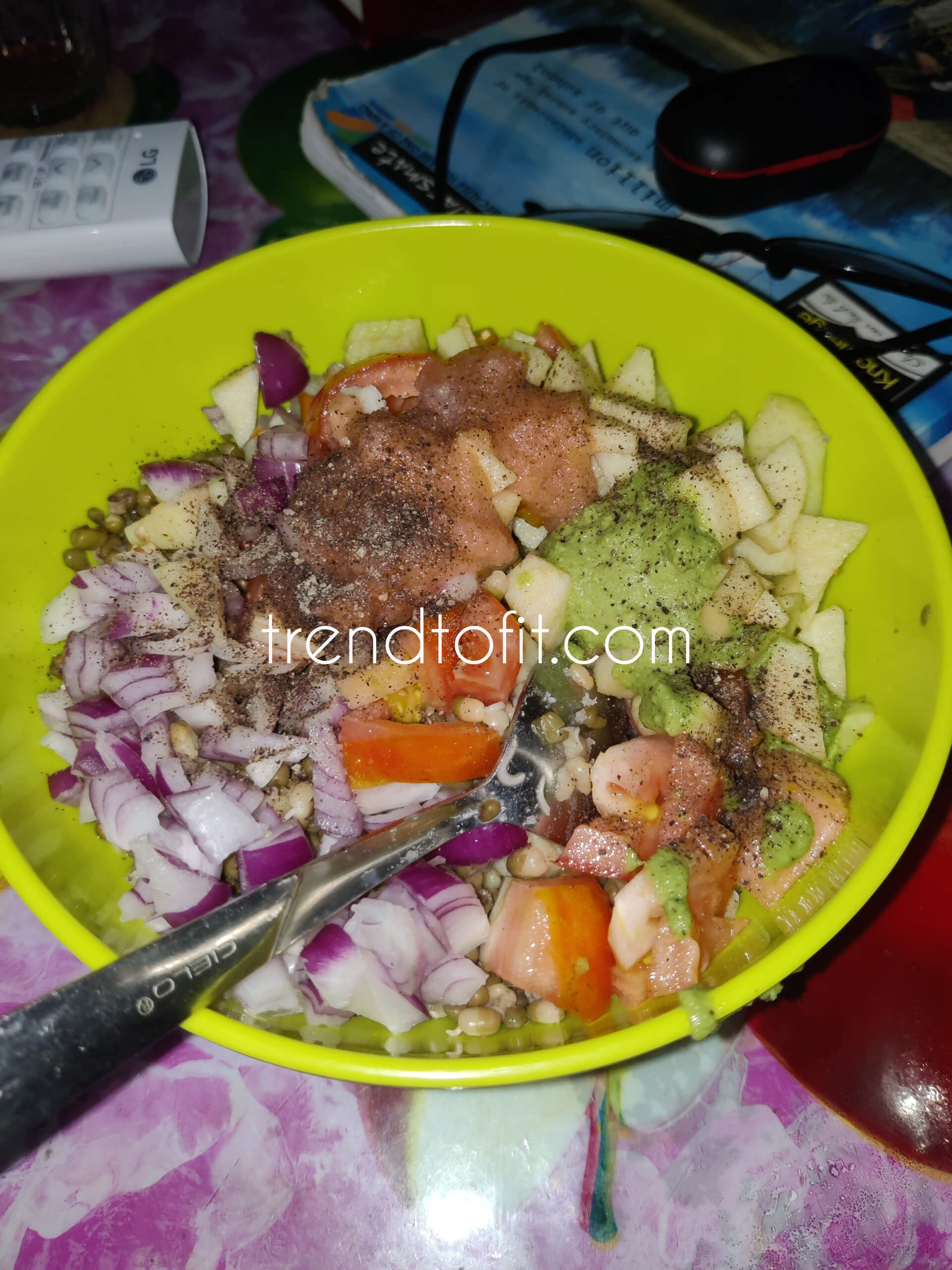
One of the easiest high-protein breakfasts to make every morning. Some like it soupy and some dry.
So boil moong daal with water according to your taste. You can either shallow fry it with jeera powder and chilli or add it later.
5. Corn Chaat
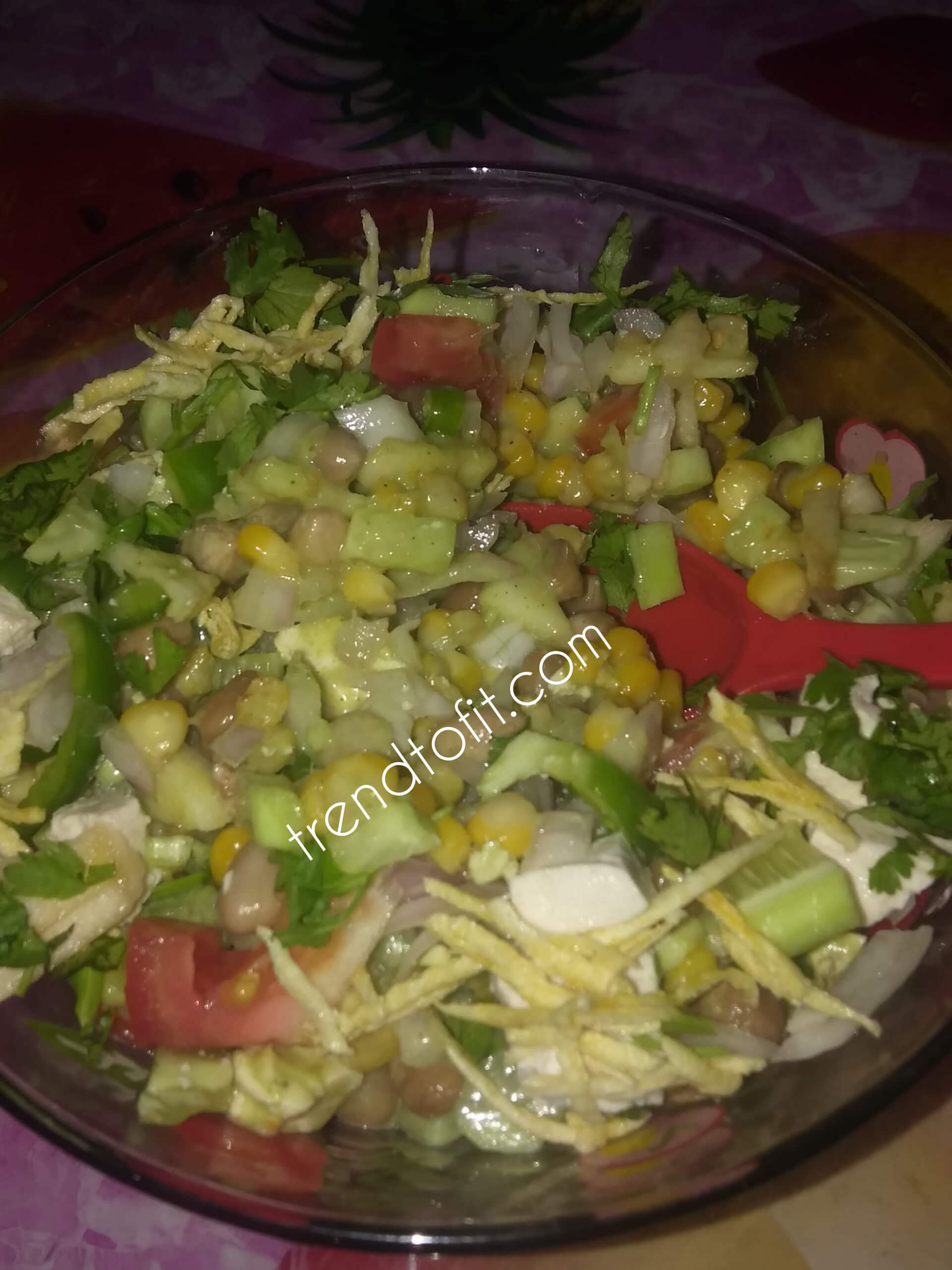
Corns are high in protein. I personally like them very much.
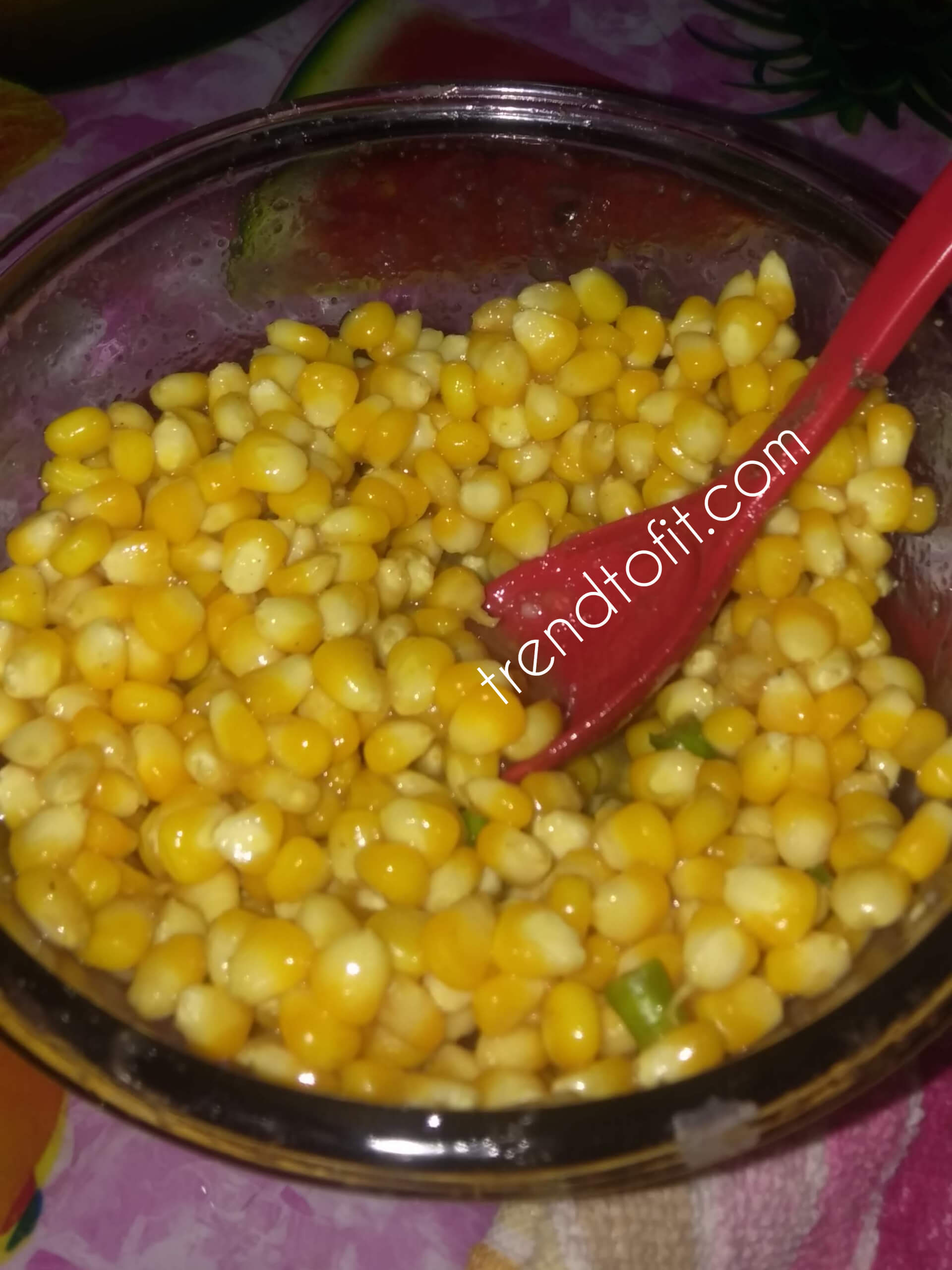
There are a no. of ways you can enjoy it. After boiling, make sweet corn, or chaat corn or eat it just by adding salt or spices. They always taste yummy and are nutritious too.
Related:
6. Momos (made with wheat flour)

Just replace refined flour with wheat flour and make the filling of daal, salad, and paneer. You’re good to go!
Trust me they taste super yummy especially when eaten hot.
Full recipe here:
7. Makhana Peanut Chaat
Very simple yet high-protein breakfast that’s super delicious!
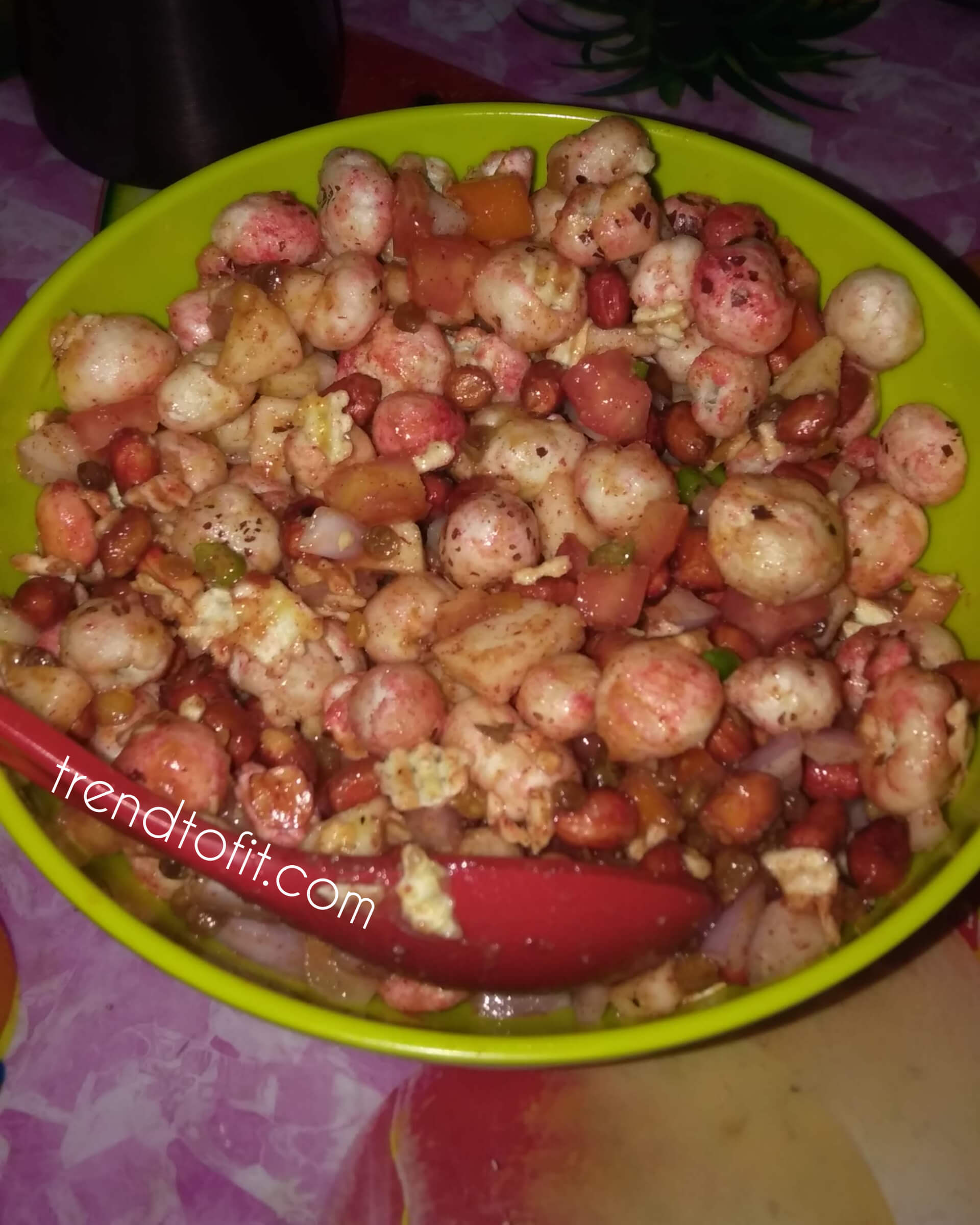

First, you need to shallow fry makhana. Then add all the high-protein foods like Dahi, peanuts, cashew, and chickpea. Spray orange juice, chutney, and sauce.

It’s up to your taste! You can add whatever you want.
8. Moong Dal Dosa or Moong Sprouts Uttapam with Salad
Most of the people like moong daal cheela. But have you ever tried them with sweet salad?
Watch here:
9. Sabudana Dal Mix Appe
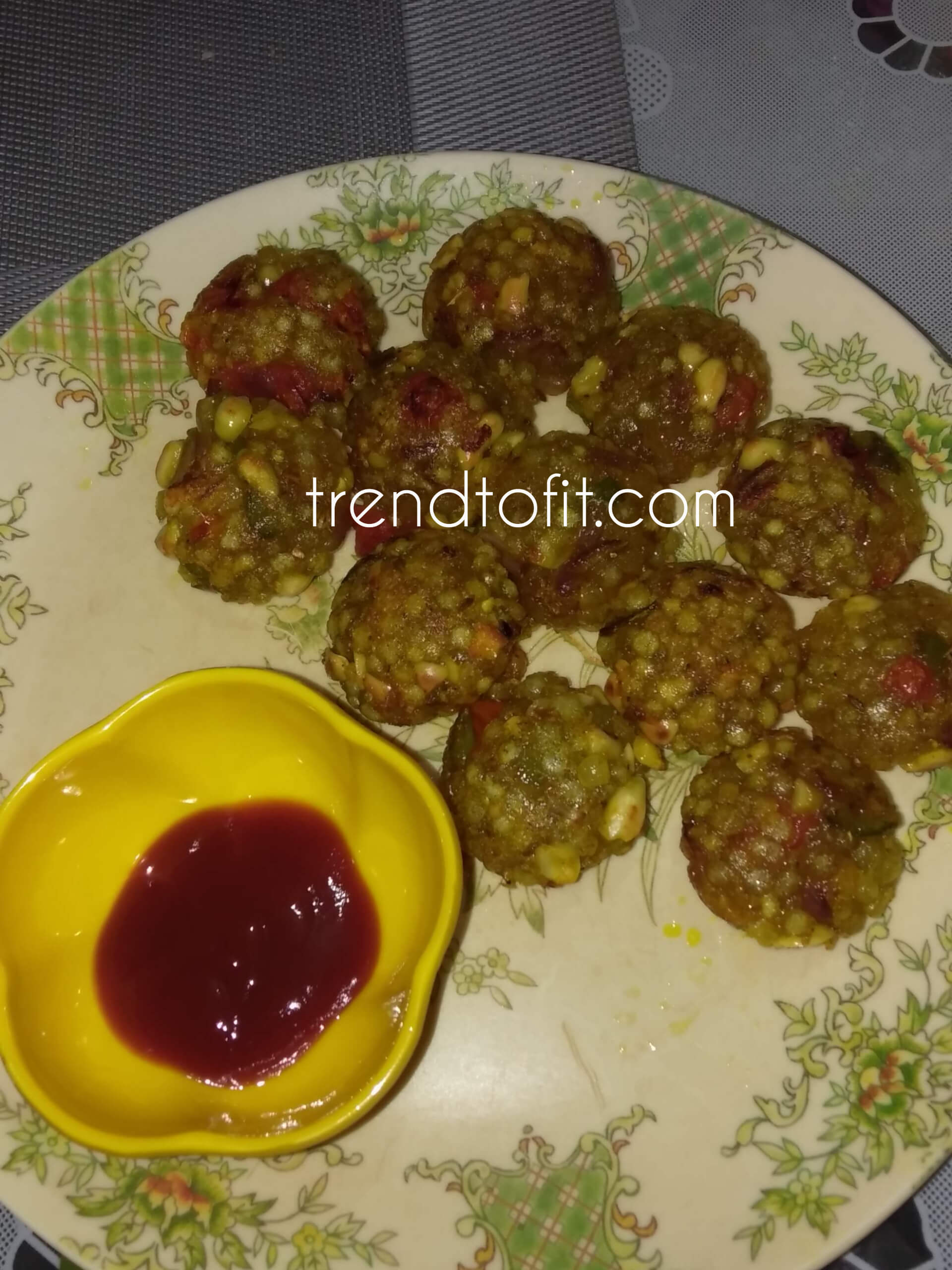
Soak Sabudana in water overnight. In the morning, rinse the water and add peanuts, and other nuts. And put the dough in an Appa pan with all added spices and salt.
A tasty high-protein breakfast is awaiting you in 15-20 mins!
10. Dhokla for High-Protein Breakfast
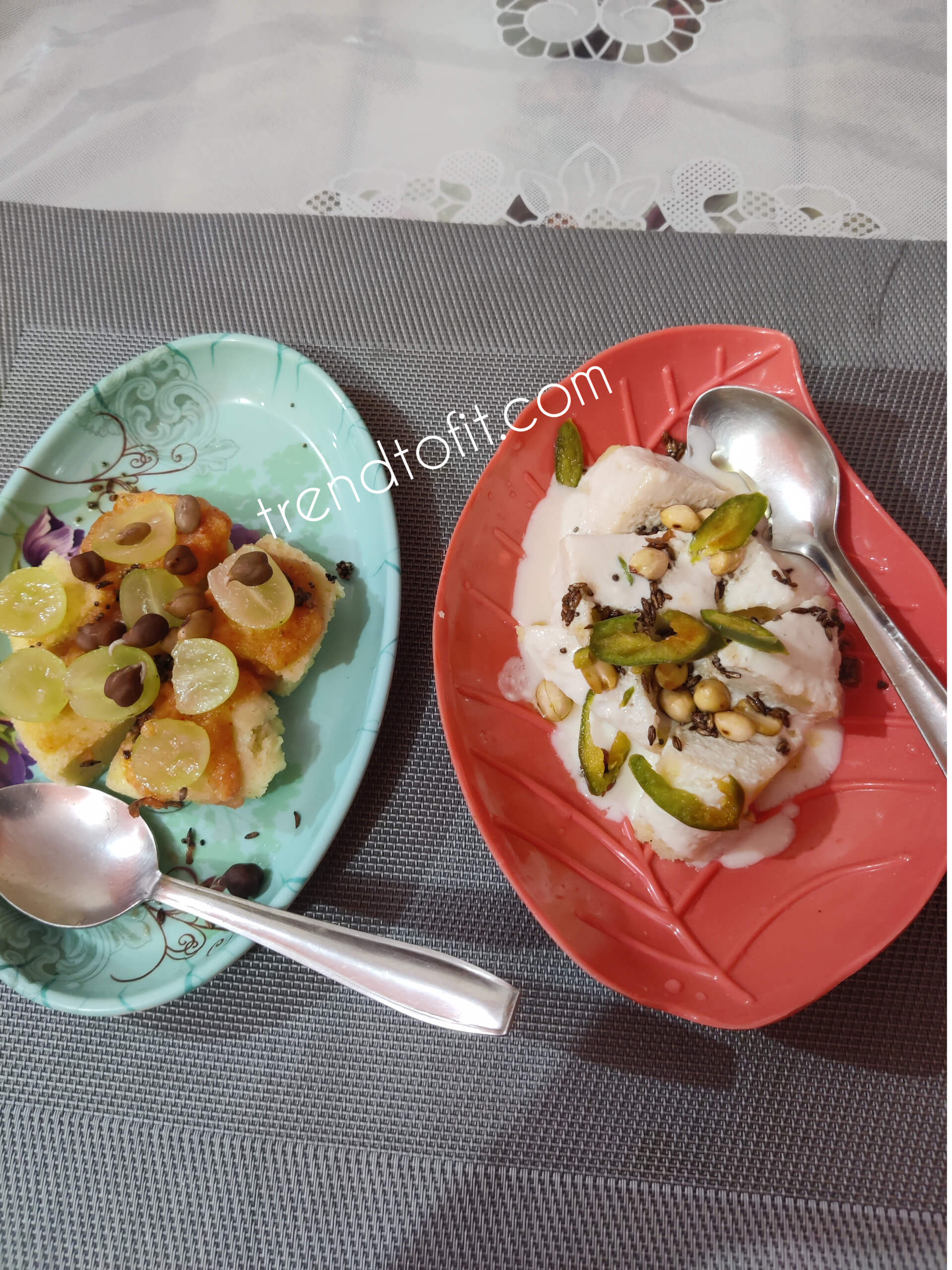
Yes, it’s a high-protein breakfast. You can try different dhoklas, chana dal dhokla, moong dal dhokla, besan dhokla. Also, add vegetables for better taste.
Garnish it with your favourite things.
11. Kabuli Chana Salad

Boil them. Put it in the microwave or air fryer to add crispiness. Then make a salad with chutney and spices.
Also read:
- 12 High-Protein Foods You can Take While on a Protein-Based Diet
- What To Eat In Breakfast: 5 Best & Worst Types Of Breakfast Foods
FAQs on Protein, Benefits & High-Protein Breakfast & Foods
1. What is Protein and What Does It Do?
Proteins are essential nutrients & the main building blocks of your body tissue used to help grow organs and nourish skin & hair, build muscles, and work as a fuel to provide energy as carbohydrates.
The most important thing is Protein is made of amino acids which play a major role to run our body. Yes, without protein, as you can see, your body can’t work.
According to Wikipedia, there are 22 types of amino acids and your body can manufacture most of them by itself but there are still 9 that it can’t make. You must have to get these 9 essential amino acids through diet.
2. How Is It An Important Nutrient for Your Body?
Numerous studies have been performed to find the benefits of a high-protein diet. They all stated that protein benefits in improving metabolic health, decreasing hunger and quick weight loss (3).
In your daily life, you need to add proteins to your diet to prevent deficiency, which leads to a serious issue: malnutrition, if occurred. Protein undernutrition results in fatigue, anaemia, physical weakness, and a weak immune system.
Do you know protein benefits for hair, beautiful skin and nails? Your hair and nails are mostly made of protein. Your body needs them to build and repair tissue and uses proteins to make enzymes and chemicals (4).
3. Does High-Protein Breakfast Benefit in Weight Loss?
Protein benefits in quick weight loss. It has been proven by experts several times. It reduces weight gain and thus helps in losing weight.
This study (5) finds how protein plays a major role in weight loss. The consumption of longer-term high protein diets showed greater weight loss, fat mass loss, reduced belly size, developed a feeling of fullness, boost in metabolism and other health benefits were also reported such as the reduction in blood pressure & cardiovascular risk factors.
One other study found that a high-protein breakfast & diet reduces appetite.
One study in obese men showed that protein at 25% of calories lowered hunger levels, reduced the desire for midnight snacking by 50% and thoughts about food by 60% (6).
According to a study, a common end-product of digested protein – Phenylalanine – triggers hormones that make you feel less hungry and cause weight loss.
You might also like to read,
- 100 Awesome Weight Loss Habits for Daily Routine
- 13 Natural Ways To Rejuvenate Your Body & Lose Weight
- 10 False Fitness Tips You Need To Stop Believing Right Now
- 40 Quick Health & Fitness Tips For Women
4. How Does High-Protein Breakfast Benefit in Increasing Lean Muscle Mass & Strength?
Proteins are the main building blocks of body tissues. They are made of essential amino acids without which the body would remain dull.
It is a scientifically proven fact that protein supplements increase physical performance during both pre-workout & post-workout exercises.
Protein especially eaten in breakfast i.e. a high-protein breakfast increases training session recovery, leans body mass and builds muscles.
However, a specific protein is for specific needs. For example, Whey protein increases strength and is used as a dietary supplement.
Protein Requirements to Build Muscle
Studies say that fat-free milk is more effective for post-workout in promoting increases in lean body mass, strength, muscle hypertrophy and decreases in body fat. Milk proteins are superior to soy proteins in promoting lean body mass.
And if you are doing physical activity or building muscles, you can increase protein consumption above recommended guidelines for good results.
Though different studies have suggested different guidelines. Some scientists found that for building muscles, the daily intake of protein should be 1.2-2 g per kg.
Different studies have indicated a different amount. Some show that 1.8 grams per kg have no benefit, while others suggest that 2.2 grams per kg are best (7).
But most studies suggest that 0.7-1 grams per pound of lean mass (1.6-2.2 grams per kg) are sufficient.
This new study has stated the protein needs to be a minimum of 0.7 grams per pound or 1.6 grams per kg.
Thus eating a high-protein breakfast is essential for building muscle.
Related,
Treadmill vs Cycling: Which is better for building muscles?
5. What are the Daily Requirements of Protein for the Average Person? Does everyone need a High-Protein breakfast?
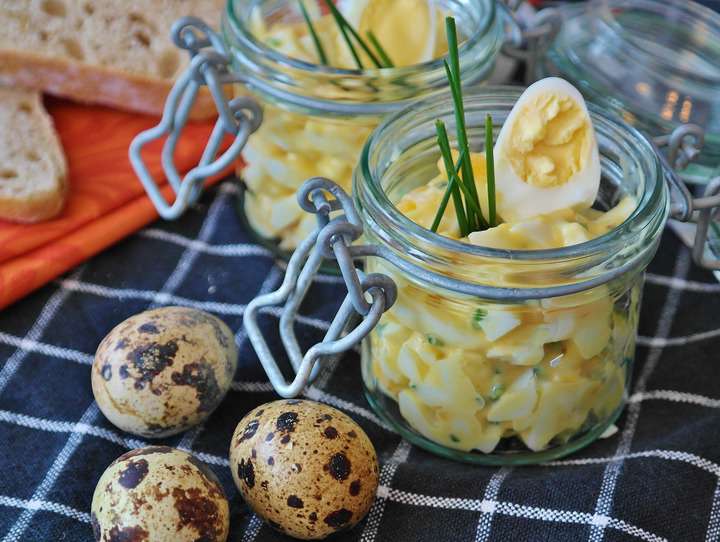
Protein benefits in repairing organs of your body so it must be included in your diet.
There are different guidelines on how much protein your body needs. But most of the nutrition guidelines suggest modest protein intake.
The DRI (Dietary Reference Intake) is 0.8 grams of protein per kilogram of body weight. WHO recommends protein intake should constitute 10-15% of your caloric intake.
However, nutrition & dietary guidelines are different for individual countries.
As per ICM (Indian Council Of Medical Research) :
Protein values for Indians are based on per kg for all ages.
For adults, the protein intake is 1.0 g / kg of weight per day
This amounts to :
- 60 grams per day for an average male weight of 60 kg.
- 55 gm per day for an average female weight of 55 kg. For pregnant women, an additional 23 grams is recommended which amounts to 78 grams per day.
- For a lactating woman (up to 6 months) an additional protein of 19 grams i.e. 74 grams per day & when the baby is between 6 to 12 months, she requires 13 additional grams of protein which amounts to 68 grams per day.
6. Tell Me About Additional Requirements of Protein
Protein benefits a lot in certain circumstances. Its intake has been suggested to increase for a specific group of people such as pregnant women, lactating mothers, growing children, athletes, bodybuilders or when the body needs to recover from malnutrition or trauma or after an operation.
Disregarding muscle mass and physique goals, physically active people do need more protein than sedentary people.
If your job is physically demanding, you walk a lot, run, swim or do any sort of exercise, you need to eat more protein and a high-protein breakfast.
Studies say, endurance athletes also need significant amounts of protein – about 1.3–1.8 grams per kg (8).
According to the National Institute of Nutrition, Hyderabad :
Protein intake guidelines for an adolescent are as follows :
- For boys (aged between 16-18 years) weighing 57 kg weight is 78 gm per day, & for the identical age group girls weighing 50 kg is 63 grams per day.
- Pregnant women require 65 gm of protein, while lactating women (up to 6 months) need 75 grams per day.
7. What Happens If You Have Too Little Protein in Your Diet?
The body’s need for protein is linked with nitrogen levels in the body.
If you don’t have enough of the right levels of the right amino acids, you would develop nitrogen imbalance, lack of energy and nutrients, weak muscle, swelling, thin hair, skin problems and lack of growth and also hormone imbalances in children.
India has a great & shocking figure for malnutrition. One in four children in India is malnourished. Lack of education is one of the major causes.
It is a well-known fact that malnutrition during pregnancy causes the child to have an increased risk of future diseases, physical & mental retardation, and reduced cognitive abilities.
Therefore, it’s recommended to take a high-protein breakfast, the first meal of your day.
Symptoms of Protein Deficiency
- Fatigue
- Anxiety
- Depression
- Loss of energy
- Anaemia
- Low strength, muscle loss, unexpected weight loss &
- Low sex drive
- Improper functioning of your immune system
8. What Happens If You Eat Too Much Protein? (Protein Benefits or Harms?)
As you saw above, too little protein results in many serious health issues on the other you must be aware of the side effects of overeating protein too.
Experts recommend that eating a high-protein diet is beneficial for your health as long as it comes from healthy proteins, or the quality of protein can increase the risk of many diseases such as heart disease, diabetes, cancer, bone health, and kidney disease.
Protein from processed red meat is linked to increased risks of these diseases.
However, an average person who is not an athlete or heavily involved in bodybuilding needs to avoid more than 2 grams/kg; which amounts to 125 grams/day for a 140-pound person (Source: Harvard health).
9. What Are Daily Protein Indian Food Resources to Make a High-Protein Breakfast?
As you know, protein benefits your body in a significant manner so you must be aware of its resources to maintain your health. My dietician & nutritionist suggested to me these food resources of protein. You can ask about it any nutritionist. These are well-known protein food resources.
Animal proteins such as eggs, dairy products, meat, poultry, and fish are of higher quality since they provide essential amino acids in the right proportion.
Even vegetarians can get enough protein by eating a combination of cereals, millet, nuts, and pulses. Milk and egg contain good-quality protein.
Vegetarian foods with protein concentrations greater than 7 per cent include soybeans, lentils, beans – kidney beans, white beans, mung beans, lima beans, lupin beans pigeon beans, wing beans, peas-chickpeas, cowpea, pigeon peas (tur dal), almonds, brazil nuts, cashews, pecans, walnuts, cotton seeds, pumpkin seeds, hemp seeds, sesame seeds, and sunflower seeds.
Some of the rich sources of protein are pulses, legumes, nuts and oilseeds, milk and milk products, meat, fish and poultry.
Whey protein is a mixture of proteins prepared from the liquid material Whey. It is very digestive and used as a dietary supplement.
10. Ayurvedic Resources of Protein Foods to Prepare High-Protein Breakfast
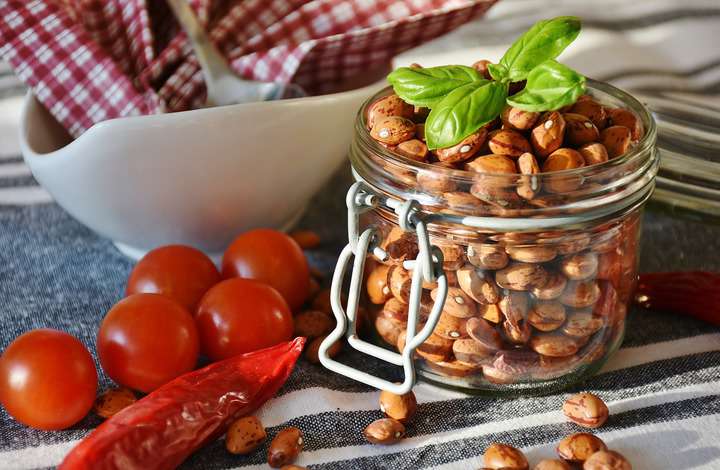
Ayurveda recommends eating beans, dal, and lentils that are well-cooked to be digested easily. Beans, dal, and lentils are rich in protein as well as they provide complex fibre, carbohydrates, and vitamins.
In India, spices are added to make them more tasty and digestible. Spices that are mostly used are cumin, black pepper, cinnamon, coriander, gram masala, ginger, saffron, mint, turmeric, etc.
Dals are Mung Dal, Masur Dal, Tur dal, Channa dal, and Urad Dal. Compared to other Dals, Mung dal is one of the low-carb pulses and is high in protein too. Other pulses (dal) are high in protein but carbs as well. Chana and mung are also used like sprouts in beans form.
Other rich sources of protein are peas, legumes, nuts and oilseeds, and milk and milk products.
Among the plant foods, soybean is the richest source of protein, containing over 40% of protein.
Note – Ayurveda suggests food that is good in aroma, and texture, nature-friendly, and violence-free. A person can be perfectly healthy being vegetarian. But you can take some fish, meat especially in soups in this diet.
But in Ayurveda, the amount and type of protein you need vary according to 3 Doshas – Vat, Pitt, and Kapha.
To know, which Dosha type are you, you should consult a good Ayurvedic doctor or take a quiz.
10.1. Vat (tendency to stay lighter)
Vat is the leader of the 3 Ayurvedic principles in the body. It is very important to keep Vata in good balance. Protein benefits in pacifying Vat.
Eat more protein, and take a high-protein breakfast but not more than you can digest easily. Eat warm cooked foods and less raw foods. Below is a Vat pacifying diet also high in protein :
Dairy: Milk products like milk, buttermilk, and curd. Always boil milk before you drink and drink it warm at least two hours before or after a full meal.
Grains: They are to pacify Vat, rice and wheat are good. Reduce the number of whole grains.
Nuts: All nuts are good.
Spices: A small quantity of black pepper is okay. Cardamom, ginger, salt, and cumin are acceptable.
Legumes: mung, tur dal, and urad dal. In moderation, red lentils and soya.
Oils: All oils pacify vat.
Fruits & vegetables: Eat sweet, watery or heavy fruits such as oranges, bananas, berries, mangoes, and melons. Reduce dry fruits such as apples, pears, and dried fruits. vegetables – cucumber, sweet potatoes, beets, carrots, asparagus. Avoid sprouts and cabbage.
10.2. Pitt (tendency to have stronger digestion & metabolism)
It governs how you digest foods. Pitt balancing protein diet is below. You can use these types of food while making your breakfast.
You should have a medium protein level if you are suffering from this dosha and your vat is not balanced. Protein benefits in pacifying pitta dosha if it is taken in moderation.
Dairy: milk, butter, and ghee are good. Avoid sour tastes such as yoghurt, cheese, and traditional buttermilk.
Legumes: Most legumes and grains (a good mix of white and whole grain)
Nuts: Almonds in nuts
Oils: olive, sunflower, and coconut oil
Fruits & vegetables: include sweet fruits such as grapes, melons, mangoes, cherries and coconut, pineapple. Reduce sour tastes such as grapefruit, and plums. Vegetables include sweet potatoes, green leafy vegetables, potatoes, cauliflower, celery, green beans, cucumber, and zucchini. You can also extract their juice with the help of a good slow juicer. Reduce hot peppers, carrots, onions, garlic, spinach, radishes, and tomatoes.
10.3. Kapha [tendency to heaviness]
Ayurveda recommends a lower level of protein mainly derived from plant proteins if your Kapha is not balanced.
Follow this diet to pacify your Kapha :
Dairy: low-fat milk, boil milk before you consume it. Add 2 pinches of turmeric or ginger before cooking it. It will reduce the Kapha increasing qualities of milk.
Legumes: Include most legumes and grains (mainly whole grains). Don’t take too much wheat and rice. Barely and millet are very good. Don’t eat tofu.
Nuts: Nuts are not good. They increase Kapha. Reduce the quantity.
Spices:: reduce salt. All the spices are delicate.
Seeds: in moderation.
Reduce sweeteners. Honey is excellent. It reduces Kapha.
Fruits & vegetables: eat light fruits such as apples, and pears. reduce heavy fruits such as bananas, figs, dates, and melons. All vegetables are good but tomatoes, potatoes, and cucumbers increase Kapha.
If you are suffering from Kapha, you should prefer a vegan diet as it tends to be light and dry, the qualities which reduce Kapha.
11. How do You Calculate How Much Protein You need?
If you’re confused about how to calculate your protein intake in a day while eating a high-protein breakfast, I have already mentioned above (suggested by the Indian Council Of Medical Research) in the article.
However, to be more clear, you can check this calculator by the government:
Also, Read :
- Top Health & Fitness Hacks To Transform Your Life Healthier
- Fitness Motivation Quotes To Keep You Going Daily
- 10 Proven Benefits Of Cinnamon Tea
- Mango Eating Benefits & Recipes
If you liked these high-protein breakfast recipes and the assay on the protein requirements, share the article with someone you care about and help them motivate to stay healthy and in shape!

A very informative article on the benefit of including Protein in our diet. Well explained
🙂
thats a really good source of knowledgeable content
Thank you so much 🙂
Thanks this is very very informative and engaging!
🙂